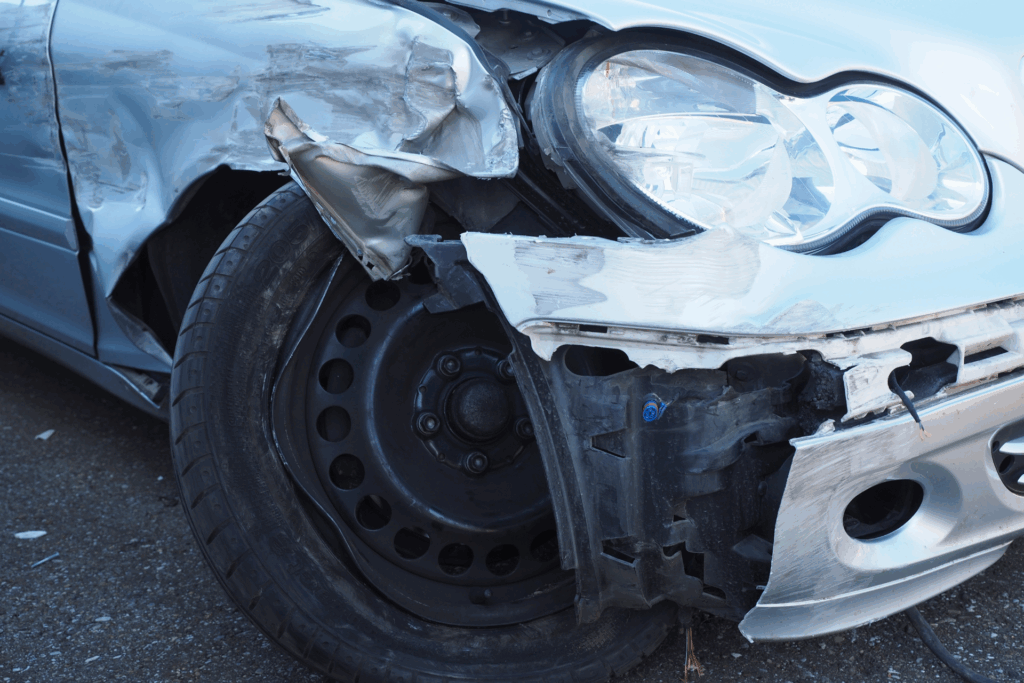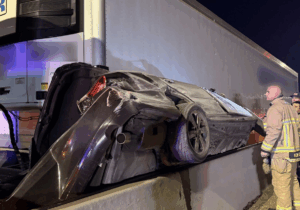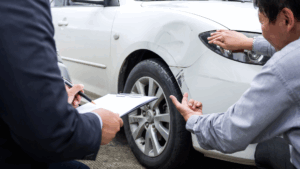The light turns green, traffic lurches forward, and—bang—your vehicle is jolted from behind. Rear-end collisions can happen in an instant.
In Arizona, multi-vehicle crashes are exceedingly common. Many families in Glendale, Phoenix, Bullhead City, and Tucson have the same questions you might have: Who is at fault? What laws apply? What should I do next?

Are Rear-Ended Crashes “Illegal” in Arizona?
A collision is not a crime. However, the driving behavior that leads to many rear-end crashes often breaks Arizona traffic laws. Two statutes come up frequently:
Following too closely: Arizona law says you cannot follow another vehicle too closely. You must consider speed, traffic, and road conditions. Violations often lead to citations after rear-end crashes.
Failure to control speed: Drivers must control their speed to avoid colliding with any person, vehicle, or object. If a driver strikes the vehicle ahead, someone commonly cites this statute.
In simple terms, a rear-end crash isn’t “illegal.” However, tailgating or not controlling your speed is illegal. These violations often lead to liability in rear-end crash cases.
Arizona also enforces a hands-free requirement for mobile devices. Drivers cannot use a handheld phone while driving. It can also be a reason for fault in a rear-end crash caused by distraction.
Why Rear-Ended Collisions Happen (Top Causes)
- Tailgating / inadequate following distance (common in stop-and-go corridors and near busy Phoenix interchanges).
- Speeding or speed too fast for conditions, reducing stopping distance.
- Distracted driving (texts, apps, calls) despite Arizona’s hands-free law.
- Sudden braking & traffic waves at intersections and freeway ramps (think US-60, I-10, Loop-101).
- Weather / visibility (dust, monsoon downpours) that demand longer following distances.
- Impaired or fatigued driving, slowing reaction times.
- Vehicle issues (worn brakes/tires) or unsafe lane changes in heavy urban traffic.
Safety note: ADOT reminds drivers to leave space and avoid tailgating. This helps prevent rear-end crashes.
Is The Rear Driver Always at Fault?
Fault is not automatic. However, Arizona frequently views the following driver as careless. This happens when they follow too closely or do not control their speed. Investigators look at:
- Traffic citations (e.g., following too closely; failure to control speed).
- Skid marks, crush patterns, data from vehicle systems, and dash/traffic-cam video.
- Weather, road conditions, sudden stops, or mechanical failures.
- Front-driver factors can matter. If the lead driver suddenly braked for no reason, had broken brake lights, or cut in quickly, that driver may share some blame. This is especially true under Arizona’s rules for comparative negligence.
Arizona’s Comparative Negligence, in Plain English
Jury decides fault & reduces damages: Whether contributory negligence or assumption of risk applies is always a jury question. If the jury assigns you some fault, your damages are reduced by that percentage, not wiped out. (A.R.S. § 12-2505).
No break for intentional/willful/wanton conduct: If a claimant intentionally, willfully, or wantonly caused or contributed to the injury, they don’t get the benefit of comparative negligence (A.R.S. § 12-2505).
What this means in rear-end cases
Even if the trailing driver is cited, fault can be shared. Example: if a jury finds the front driver 20% at fault (e.g., no brake lights or an abrupt cut-in), the front driver’s recovery is reduced by 20%. Arizona also apportions fault among all parties, and defendants are generally liable only for their several shares of fault. (A.R.S. § 12-2505 and related apportionment rules.)
Local Insight for Glendale, Phoenix, Bullhead City & Tucson
Urban corridors (I-10, I-17, Loop-101/202, SR-51) and busy roads in Glendale and Phoenix see frequent stop-and-go waves—classic conditions for rear-ended crashes. Tucson’s stretches near I-19 and Grant/Speedway, and Bullhead City’s high-traffic tourist weekends, can produce similar patterns. The same core rules apply statewide: leave space, control speed, and avoid distractions—and if a crash happens, document everything.
What We Provide When Accidents Turn Your Life Upside Down
Compassion First
Your case is more than a file. Your story is heard and respected at every step.
Guidance You Can Trust
From insurance negotiations to building evidence around Arizona statutes, our team provides clear, strategic direction.
Support for Healing
Recovery touches more than the body. We help connect clients with medical, counseling, and community resources.
Whether you’re dealing with whiplash, back injuries, or a totaled car after a rear-ended crash in Arizona, we encourage you to reach out. Accident Justice offers:
- Free, no-obligation consultations
- 24/7 availability when you need to talk
- Clear, compassionate communication from start to finish
Call to Action
If you were involved in a rear-end collision in Arizona, get answers tailored to your situation.
Contact Accident Justice Law → (602) 884-8886 | Free Consultation
Connect with us: Facebook, Instagram, LinkedIn, Tiktok, Youtube
This article is for general information and is not legal advice.



